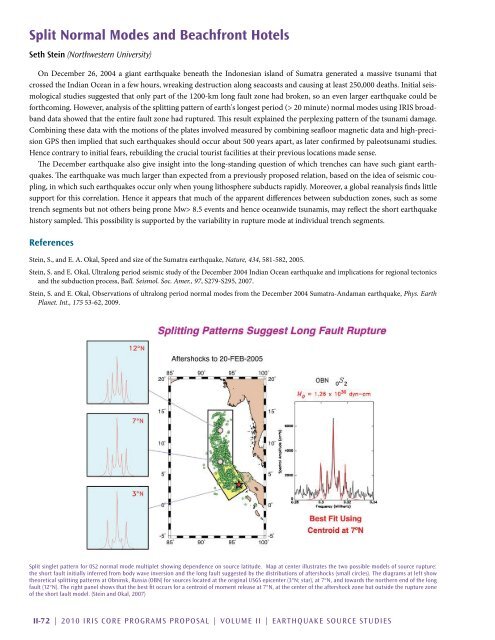Download Volume II Accomplisments (28 Mb pdf). - IRIS
Download Volume II Accomplisments (28 Mb pdf). - IRIS
Download Volume II Accomplisments (28 Mb pdf). - IRIS
You also want an ePaper? Increase the reach of your titles
YUMPU automatically turns print PDFs into web optimized ePapers that Google loves.
Split Normal Modes and Beachfront Hotels<br />
Seth Stein (Northwestern University)<br />
On December 26, 2004 a giant earthquake beneath the Indonesian island of Sumatra generated a massive tsunami that<br />
crossed the Indian Ocean in a few hours, wreaking destruction along seacoasts and causing at least 250,000 deaths. Initial seismological<br />
studies suggested that only part of the 1200-km long fault zone had broken, so an even larger earthquake could be<br />
forthcoming. However, analysis of the splitting pattern of earth's longest period (> 20 minute) normal modes using <strong>IRIS</strong> broadband<br />
data showed that the entire fault zone had ruptured. This result explained the perplexing pattern of the tsunami damage.<br />
Combining these data with the motions of the plates involved measured by combining seafloor magnetic data and high-precision<br />
GPS then implied that such earthquakes should occur about 500 years apart, as later confirmed by paleotsunami studies.<br />
Hence contrary to initial fears, rebuilding the crucial tourist facilities at their previous locations made sense.<br />
The December earthquake also give insight into the long-standing question of which trenches can have such giant earthquakes.<br />
The earthquake was much larger than expected from a previously proposed relation, based on the idea of seismic coupling,<br />
in which such earthquakes occur only when young lithosphere subducts rapidly. Moreover, a global reanalysis finds little<br />
support for this correlation. Hence it appears that much of the apparent differences between subduction zones, such as some<br />
trench segments but not others being prone Mw> 8.5 events and hence oceanwide tsunamis, may reflect the short earthquake<br />
history sampled. This possibility is supported by the variability in rupture mode at individual trench segments.<br />
References<br />
Stein, S., and E. A. Okal, Speed and size of the Sumatra earthquake, Nature, 434, 581-582, 2005.<br />
Stein, S. and E. Okal, Ultralong period seismic study of the December 2004 Indian Ocean earthquake and implications for regional tectonics<br />
and the subduction process, Bull. Seismol. Soc. Amer., 97, S279-S295, 2007.<br />
Stein, S. and E. Okal, Observations of ultralong period normal modes from the December 2004 Sumatra-Andaman earthquake, Phys. Earth<br />
Planet. Int., 175 53-62, 2009.<br />
Split singlet pattern for 0S2 normal mode multiplet showing dependence on source latitude. Map at center illustrates the two possible models of source rupture:<br />
the short fault initially inferred from body wave inversion and the long fault suggested by the distributions of aftershocks (small circles). The diagrams at left show<br />
theoretical splitting patterns at Obninsk, Russia (OBN) for sources located at the original USGS epicenter (3°N; star), at 7°N, and towards the northern end of the long<br />
fault (12°N). The right panel shows that the best fit occurs for a centroid of moment release at 7°N, at the center of the aftershock zone but outside the rupture zone<br />
of the short fault model. (Stein and Okal, 2007)<br />
<strong>II</strong>-72 | 2010 <strong>IRIS</strong> Core Programs Proposal | <strong>Volume</strong> <strong>II</strong> | Earthquake Source Studies
















